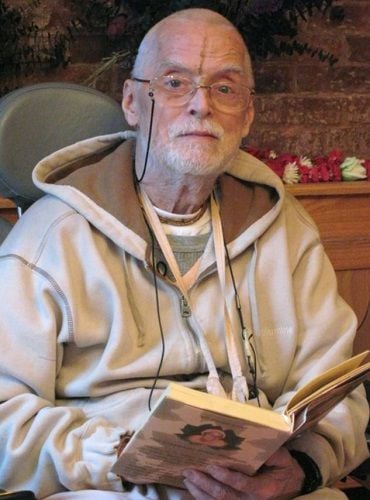PERSONAL INFORMATION
Other name: Swami Bhaktipada (Bhaktipāda) [1] The Independent
Real name: Keith Gordon Ham [2] The New York Times
Profession(s): Spiritual Leader, Author
Known For: Being the co-founder of the New Vrindaban, a Hare Krishna community in Marshall County, West Virginia
Date of Birth: 6 September 1937 (Monday)
Birthplace: Peekskill, New York, USA
Age (at the time of death): 74 Years
Zodiac sign: Virgo
Nationality: American
Hometown: Peekskill, New York, USA
Religion: He belonged to a Christian family, and later, he adopted Hinduism. [5] ISKCON News
Age: 74 Years
Check Out Other Celebrities Biography
- romy biography
- ravi sihag ias biography
- renuka singh thakur cricketer biography
- shikhar pahariya biography
- ranjit bawa biography
EDUCATION
School(s): • Drum Hill Junior High School, US (1952) • Bob Jones Academy in Greenville, South Carolina • Keith attends Stony Brook School in Long Island, New York (1953) • Peekskill High School, New York (1955)
College/University: • Maryville College, Maryville, United States • University of North Carolina, Chapel Hill, United States • Columbia University in New York
Educational Qualification(s): • Bachelor of Arts in History at Maryville College, Maryville, United States • University of North Carolina, Chapel Hill, United States • PhD at Columbia University in New York (dropped) [4] The Independent
PHYSICAL STATISTICS
Height (approx.): in centimeters – 168 cm in meters – 1.68 m in feet & inches – 5’ 6”
Eye Colour: Hazel Brown
Hair Colour: Grey (half bald)
FAMILY & RELATIONSHIPS
Marital Status: Unmarried
Affairs/Boyfriends: Howard Morton Wheeler (spiritual leader)
Wife/Spouse: N/A
Parents: Father – Francis Gordon Ham (conservative Baptist minister) Mother – Marjorie
Siblings: Brother – Gerald (archivist) Sister – Shirley, Joan, and Roberta (image in paerents’ section)
OTHER INFORMATION
Date of Death: 24 October 2011
Place of Death: A hospital in Thane, Maharashtra
Death Cause: Collapsed Lungs and Kidney Failure [3] The Independent
Sexual Orientation: Homosexual
INTERESTING BACKGROUND INFORMATION
Kirtanananda Swami, a prominent spiritual leader and author, is best known for co-founding the New Vrindaban, a unique Hare Krishna community nestled in the heart of Marshall County, West Virginia. Born into a Christian family in New York, Kirtanananda faced significant health challenges during his formative years, grappling with hepatitis and polio. Despite these adversities, he displayed an early aptitude for debate in school, setting the stage for a life that would straddle the realms of spirituality and societal debate. During his college years at Maryville College, he excelled academically, topping his class in 1959 and earning a prestigious Woodrow Wilson fellowship to study American history at the University of North Carolina at Chapel Hill.
While in North Carolina, Kirtanananda formed a significant relationship with a fellow student, Howard Morton Wheeler. Their bond blossomed into a homosexual relationship that lasted for several years. However, the couple’s time at university was cut short when they faced the threat of an investigation into their personal lives, prompting them to relocate to New York City. In this vibrant yet turbulent setting, Kirtanananda began exploring the counterculture of the time, promoting the use of LSD and working as an unemployment claims reviewer. Despite this tumultuous chapter, Kirtanananda would later reflect on his relationship with Howard, acknowledging the shift to celibacy once he embraced the Hare Krishna lifestyle.
His spiritual journey took a transformative turn in June 1966 during a visit to India, where he met A.C. Bhaktivedanta Swami Prabhupada, the founder of the International Society for Krishna Consciousness (ISKCON). Upon returning to the U.S., Kirtanananda’s dedication to Prabhupada’s teachings deepened, leading to his initiation on September 23, 1966, when he was given the title ‘Kīrtanānanda Dāsa.’ He soon became an integral part of the ISKCON community, assisting in various temples and earning the affectionate nickname “Kitchen-ānanda” for his culinary skills. His partner, Howard, also joined ISKCON, adopting the title Hayagriva Dāsa. Kirtanananda’s commitment to the movement solidified with his adoption of a renounced lifestyle in India in August 1967, where he took a vow of lifelong celibacy and was thereafter titled Kīrtanānanda Swāmi.
As Kirtanananda established himself within the Hare Krishna movement, he began to assert his vision for the New Vrindaban community, which grew rapidly and became known as a spiritual retreat attracting thousands of devotees annually. He initiated the construction of the Palace of Gold as a sanctuary for his guru, Swami Prabhupada, which would become an iconic destination within the community. However, his leadership style often clashed with traditional ISKCON principles, leading to tensions. In March 1979, Kirtanananda was awarded the honorary title ‘Bhaktipāda,’ but by 1987, he faced expulsion from ISKCON due to alleged deviations from core teachings. This prompted him to start a new organization, The Eternal Order of the League of Devotees Worldwide, where he continued to promote a blend of faiths, adapting devotional practices to include Western influences.
In the years that followed, Kirtanananda’s life was marked by both triumph and tragedy. He suffered a severe head injury in 1985 that altered his behavior and strained relationships within his community. Despite the controversies surrounding his leadership, Kirtanananda remained a prolific author, penning around 24 spiritual books translated into multiple languages and contributing numerous articles and poems. After relocating to India in 2008, he focused on preaching unity among religions, reflecting on the importance of understanding and tolerance in a fragmented world. Kirtanananda’s legacy continued even after his passing in 2011, with various documentaries and books chronicling his complex life and the impact he had on the Hare Krishna movement, as well as the spiritual landscape of his time.
—
Note: All biographical information compiled from publicly available sources.
